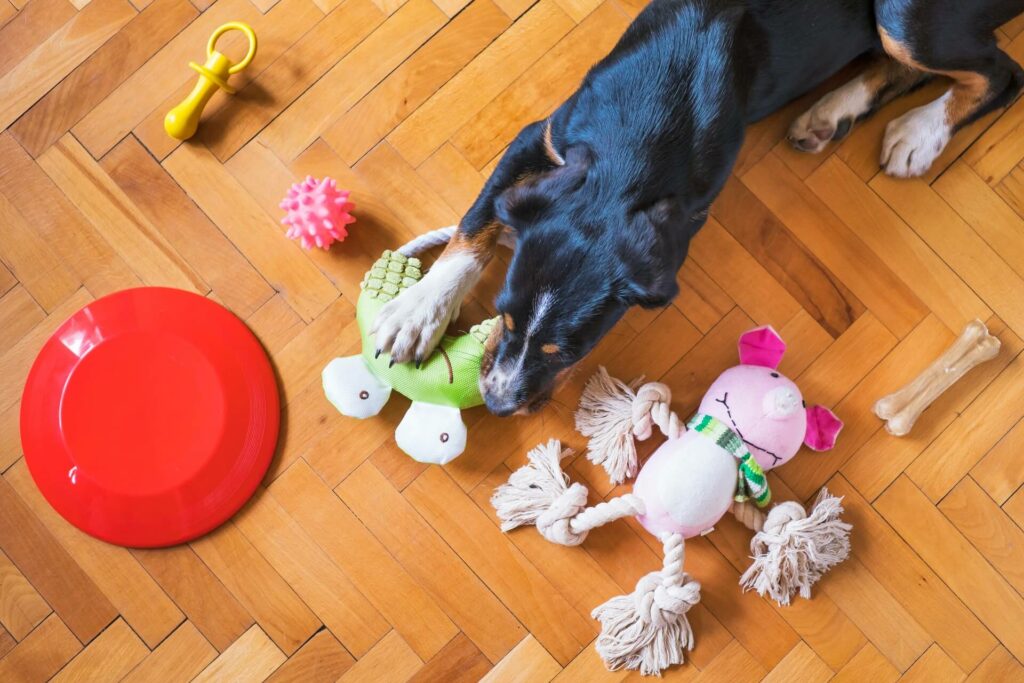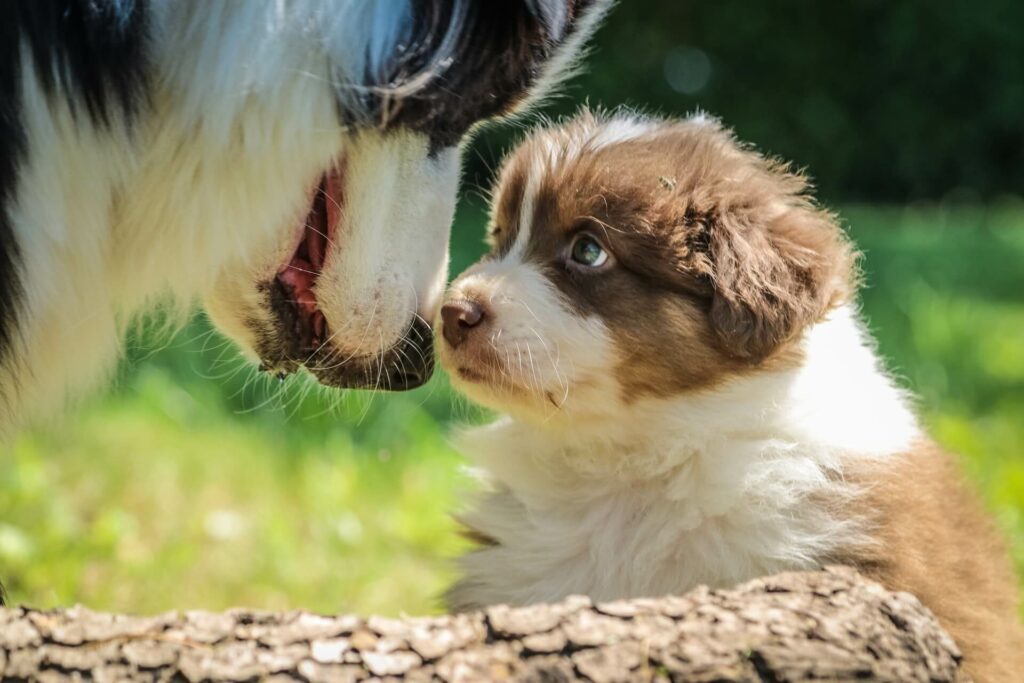Let’s say a total stranger walked into your house, put on your favorite pajamas, got comfortable in your bed, and logged into your Netflix account. You’d probably feel pretty damn uncomfortable!
That’s how your dog might feel if a new puppy was suddenly brought into your home without any warning or preparation.
Giving your dog a canine companion is terrific, but you should prepare for that initial meeting to make sure everything goes smoothly.
We’ve compiled the most important info about how to introduce an energetic puppy to an older dog—that way no one will be in for an uncomfortable surprise.
How to prepare for your puppy’s arrival
It’s important to ease the dog you already have into the reality of their frisky new roommate.
Introducing your new pup should actually begin a couple of weeks before you bring the puppy home. Put the new puppy’s toys, bedding, and food bowl in a separate room so that your dog can start to get familiar with the new smells.
You’ll also want to create separate areas for the puppy and the dogs you already have. Ideally, you’ll put their stuff in separate rooms, but a crate or a play pen also works! Your dog might become possessive over their belongings when the puppy tries to play with them—and you’ll want to avoid any fighting over food or toys. By giving each dog its own space, you’ll prevent anyone from feeling like their paws are being stepped on.

Meeting outside for the first time
After you’ve prepared everything inside your home, it’s time for the dogs to meet! Choose a neutral setting, like a park, so that your resident dog doesn’t feel territorial.
Have both dogs on leashes, with a different person walking each dog. Don’t forget to bring tons of treats for both pups to encourage good behavior! Allow your dog and puppy to first see each other from a distance. If neither shows any negative behaviors, give them a treat… and slowly walk the dogs towards each other, giving them more treats if they stay calm.
When you’re close, let the dogs sniff each other and pay close attention to their body language. If either one of them seems stressed, take a step back and give them their space. According to PetPlace, you should look out for key signs: growling, snarling, raised fur, or sustained stares. Take it nice and slow; there’s no need to rush.
After a successful face-to-face (nose-to-nose?) meeting, take both dogs on a walk while keeping a close eye on their body language. They might be super excited to play together, but it’s also possible that they need some time. Listen to what they need, and even though it’s such a lovely moment, remember that it might take some time to get them used to one another.

First meeting inside the house
Once the dogs seem to be comfortable around each other in a neutral setting, the time has come to welcome your new puppy to their new home.
Separate the pups with a (tall) baby gate so that you can observe how they interact with each other. It’s very important to keep giving them treats whenever they show positive or appropriate behavior. This will reinforce the healthy interactions that you’re looking for.
At first, you should never leave the dogs alone unsupervised. Once you’re a bit more confident, get rid of the baby gate and have the dogs together in the same room (although still supervised!).
A puppy still has a ton to learn, especially around an older dog that might not appreciate their constant bursts of energy.

Eventually, you can experiment with your puppy and older dog in the same room, alone. You can start off by leaving them alone together when you’re in a different room and able to hear any sounds that indicate distress or unhappiness. If all goes well inside the home you can try to leave them alone for a minute while you’re outside the house, then build up to a couple of minutes, an hour, etc… One puppy-step at a time.
Every dog is unique, and it is possible that things won’t go according to plan. No worries: There are many dog trainers or animal behaviorists out there that can offer insights and advice. Don’t be hard on yourself if you need a little help from a professional.
What to do (and not to do!) during the first weeks
There are a couple of no-no’s and some definite yesses when introducing a puppy to your other dog(s). Let’s take a look:
DO get vaccinations!
Puppies are more vulnerable to infections than older dogs, so make sure the pup is vaccinated before introducing them. Having your dogs stay safe and healthy is crucial.
The Vet West recommends only introducing a puppy to other dogs after their first vaccination. It’s also important to make sure that the adult dog is vaccinated as well. Having pet insurance can help to reduce the costs of vaccinations and vet visits.
DO schedule monitored playtime
Allow and encourage monitored playtime. This teaches boundaries to the puppy and other important socialization skills.
DO keep the status quo for the resident dog
Mansi, pet parent of Maynard and Chloe, two beautiful beagles, stresses how important it is to keep your older dogs’ schedule similar to what it was before the puppy arrived—and to make sure that you never give less attention to your older dog. That’s easier said than done, but you don’t want your dog to resent the new dog for changing his cozy and comfortable life.
DO have the best time (duh)
Enjoy this period as much as possible and take plenty of pictures and videos! Puppies unfortunately grow up very quickly and you’ll want to look back at the time when your fur baby was still so small and cute.
DON’T force the pups to spend time together
Take everything one tiny step at a time. Never force them to do something they’re not ready for yet. The American Kennel Club advises to give the dogs some time apart every now and then. This alone time will allow them to relax and recharge.
DON’T ignore signs of aggression
Watch out for any signs of aggression and never allow your dogs to fight. If you sense tension or they start brawling, break it up as soon as possible. Fighting is never a good idea, and leaving them fighting doesn’t mean they’ll get it out of their system.
Don’t have time for all this prep?
Everything we’ve discussed is only possible if you have enough preparation time, which is not always the case when adopting. Natasha, pet parent of Maya and Peanut, two incredibly cute and Insta-famous Dachshunds, shared some thoughts with us.
“It took Maya two weeks before she started warming up to Peanut. She was NOT happy when she arrived. If I’d do anything differently I think I’d probably get her an Adaptil calming collar to see if that would help. It was very last minute as we had not intended to get Peanut so we didn’t really have time to prepare anything.”
If you’re in a similar situation than the one Maya and Peanut were in, you can give your older dog something to help them cope with the stress of the sudden change, like a pheromone collar or CBD oil. Consult your vet about the best options.
Sometimes things don’t go according to plan—and that’s okay!
Life is full of unexpected situations. Remember that the most important thing is to stay calm! Dogs are sensitive beings and can feel it when you’re stressed or anxious—which doesn’t help the process… So again, stay calm, trust the process, and reach out to experts when in doubt.
And while your new puppy is settling in, consider getting them Lemonade Pet insurance! It’s generally more affordable when they’re young, and you won’t risk being denied coverage for pre-existing conditions your pet might develop later in life.




